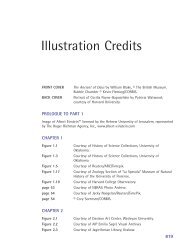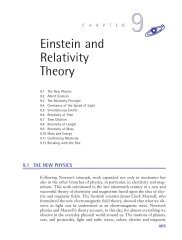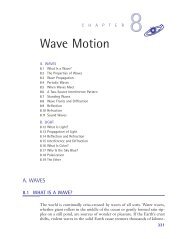Chapter 12: Electromagnetic Waves (545 KB) - D Cassidy Books
Chapter 12: Electromagnetic Waves (545 KB) - D Cassidy Books
Chapter 12: Electromagnetic Waves (545 KB) - D Cassidy Books
Create successful ePaper yourself
Turn your PDF publications into a flip-book with our unique Google optimized e-Paper software.
3637_<strong>Cassidy</strong>TX_<strong>12</strong> 6/13/02 11:33 AM Page 550550 <strong>12</strong>. ELECTROMAGNETIC WAVESFIGURE <strong>12</strong>.1Blaikley).Faraday’s Christmas Lecture at the Royal Institution, London (painting bythat an electric current in a conductor can turn a nearby magnet (see <strong>Chapter</strong>10).Faraday, too, had been guided by a belief in the unity of natural forces.Could light be another form of this basic “force”? Or rather, to use moremodern terms, is light a form of energy? If so, scientists should be able todemonstrate experimentally its connection with other forms of energy suchas electricity and magnetism. Faraday did succeed in doing just this. In1845, he showed that light traveling through heavy glass had its plane ofpolarization rotated by a magnetic field applied to the glass.Having shown a definite connection between light and magnetism, Faradaycould not resist going one step further in his unrehearsed lecture thefollowing year, revealing thoughts he had held privately. Perhaps, he suggested,light itself is a vibration of magnetic lines of force. Suppose, for example,that two magnetized or charged objects are connected by a magneticor electric line of force. If one of them moved, Faraday reasoned, adisturbance would be transmitted along the line of force. Furthermore, iflight waves were vibrations of lines of force, then a hypothetical elastic substancesuch as “ether” would not be needed in order to explain the prop-






